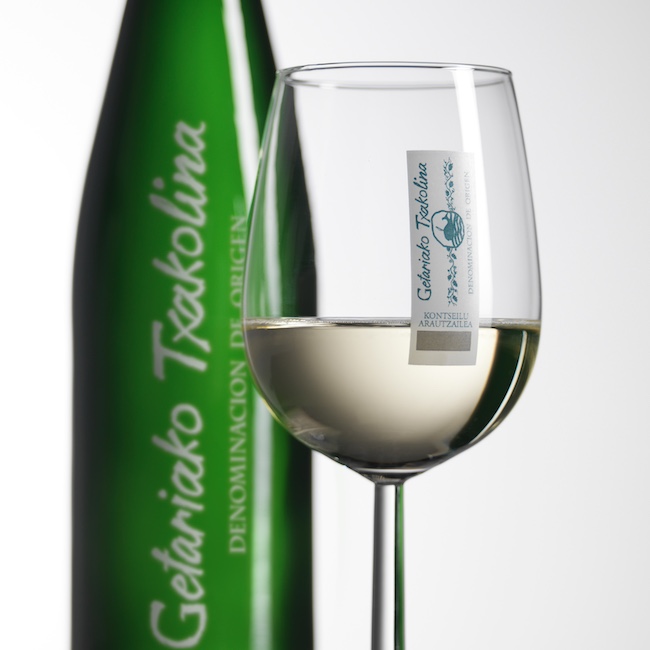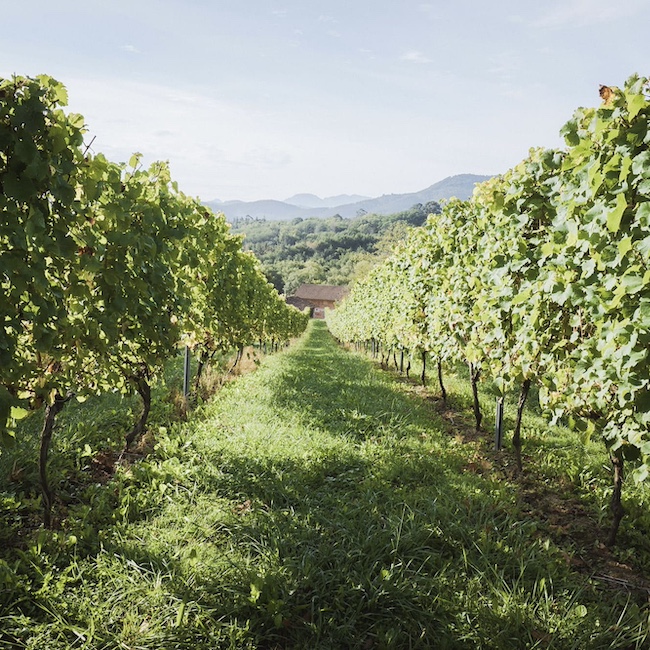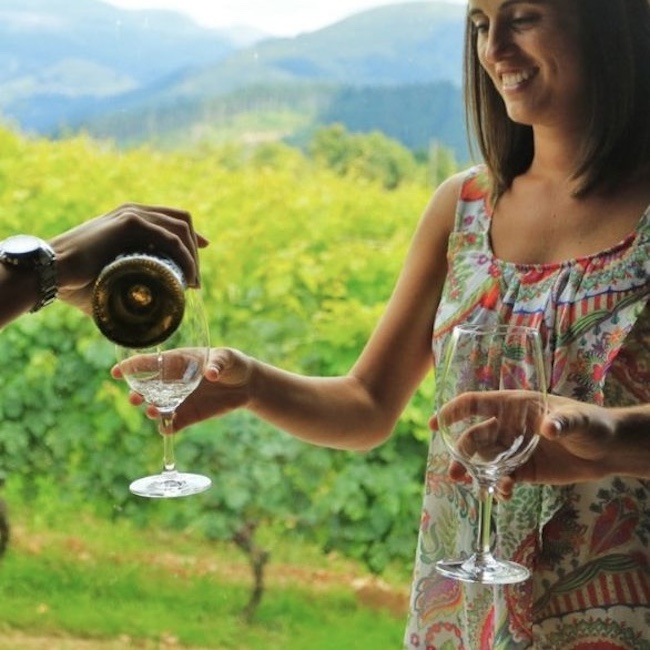by Amber Rill - @rilltravels
.png.transform/rendition-xs/image_image%20(1).png)

by Amber Rill - @rilltravels
Hondarrabi Zuri is a historic, regional grape, tended by passionate growers and winemakers, to tell a story of Basque identity through wine
While many consumers may not have heard of Txakoli, they're familiar with other great white wine regions of the world, whose grape(s) are ambassadors of their climate, reflections of their soil, and chameleons in the hands of their winemakers, changing colors but always retaining their true character. Albariño or Viura from Spain are examples, and Hondarrabi Zuri from Txakoli should follow.
The wine is known as Txakoli, a reflection of its environment, a coastal wine that sings with lightning acidity, classically drank in its youth with the bounty of Atlantic seafood. While this is typically consumers first entry into Txakoli, there is a tide of change within the region, with three distinct Denominación de Origen (DOs); and winemakers who are proving that Txakoli is more than just an aperitif wine.
The three provinces for Txakoli each have a corresponding DO, and each shows distinct attributes. Txakoli is primarily a white wine region, based on the local grape variety, Hondarrabi Zuri. Txakoli roughly translates to "of home" or "farm wine", referencing the fact that the grape has been used throughout history for local consumption. Hondarrabi Zuri is a colloquial name for a collection of varieties, shown through DNA testing to refer to three grapes, Courbu Blanc, Crouchen, and Noah. The diversity of these plantings adds to the complexity of the wines. Fresh yellow and green citrus, white flowers, sea spray, and mouthwatering acidity are qualities of Hondarrabi Zuri. Onditz Eizagirre of Talai Berri confirms the appeal of Txakoli, noting that "the future lies in light, fresh, and aromatic wines", and states that the indigenous grapes are well adapted to the local climate and terrain.

Getariako Txakolina: The Influence of the Sea
Getariako Txakolina DO is the most prominent, historical DO. Nestled against the Bay of Biscay, the wines of Getariako are strongly marked by the influence of the sea, grown on the traditional parral (pergola) system of training. The most classic style of Txakoli comes from this appellation, high acid, youthful expressions with lemon fruits and salty minerality, often poured from high into glasses below in the same style as Basque cider. Plantings are also increasing inland in Getariako, with producers opting for modern vertical shoot position trellising, which lowers yields, and is better suited to the drier interior climate. Due to the prominence of the DO, Getariako often provides vine material for plantings in Arabako and Bizkaiko and some has vineyards that are more than a century old. The producers of Getariako have the largest share of the market space, but even so, the largest wineries, such as Txomin Etxaniz and Ameztoi remain family run. When enjoying Txakoli from Getaria, this generally crisp, light bodied expression is terrific with the native Atlantic seafood, grilled fish, oysters, boquerones, padrón peppers, and shrimps with garlic and pepper.

Pushing the Limits in Bizkaiko Txakolina DO
Bizkaiko Txakolina DO has a more varied climate, and vines are spread out over the entire province, with great differences in rainfall and elevation within the DO. If Getariako is the historical heartland, with the most traditional producers, Bizkaiko is the antithesis, anti-tradition producers who are pushing the envelope and showing Hondarrabi Zuri as grape worthy of thoughtful, intentional winemaking. Producers are experimenting with longer lees aging, blending with accessory varieties like Hondarrabi Zuri Zerratia (Petit Corbu), wood influence, and more.
Bodegas Itsasmendi has vineyards in 13 different municipalities in Bizkaiko, and Technical Director and founding member Garikoitz Ríos Urbaneta explains that the enormous geological and microclimatic diversity of the area is what lead them to experiment with different harvest dates, multiple fermentation vessels, and longer lees aging for their wines. Appellation regulations require lower yields, and Bizkaiko has also released an additional classification system as indication of style. Wines that have been aged a minimum of five months may be labeled as Bereziak, and three terms may be used for specific styles; traditional or ancestral method sparkling wines may be labelled as Apardunak, late harvest wines may be leveled as Uztagoienak, and other styles may be defined as Apartak. However producers choose to label their Bizkaiko Txakoli, winemakers here are challenging the traditional light, early consumption style associated with Getariako, with a goal to increase the complexity, and reputation of Txakoli as a wine worthy of extended aging. The additional richness from extended lees aging, and the more continental inland areas make Bizkaia Txakoli a match for richer seafood like crab, lobster, mackerel on the grill, roast chicken, potatoes, and bacalao.

Arabako Txakolina DO is the youngest, and smallest of the three DOs, established by the 5 remaining producers in 2001. Landlocked, it abuts Rioja Alavesa to the south, and has the fewest number of producers, with 8 as of 2020. While there is some maritime influence, the region is marked by a continental climate, with a drier growing season and a mountainous geography. The wines of Arabako can be quite powerful comparatively, with an extended growing season and a delay in harvest producing ripe grapes with a phenolic weight and texture. Arabako Txakoli typically eschews the spritz common in Getariako. In 2022, the DO voted to allow the sale of Arabako Txakoli in cans and kegs, looking for opportunity to expand into competitive markets like the US, where the canned wine market was worth USD 1.1 billion in 2022. Artomaña Xarmant offers Txakoli in cans and kegs in the US market, still maintaining the brands high quality identity with this alternative packaging.
The Surprising Red Txakoli
Txakoli is an intriguing wine region and should be on any wine enthusiast’s radar. While Hondarrabi Zuri and white wines dominate the region, Hondarrabi Zuri Zurratia, and even international grapes like Riesling do well. The local red grape, Hondarrabi Beltza, is around 2% of the production of the region. Doniene Gorrondona is a pioneer in the revival of red Txakoli, and historically Beltza production outgrew white production, according to Israel Tavera. Related to Cabernet Franc, Tavera describes Hondarrabi Beltza to "craft a fresh red wine with hints of green pepper, herbs, and earth, with the same hallmark high acidity of its white relative". Israel goes on to summarize that Beltza is adept at expressing the freshness of the sea by where it is grown. Israel anticipates that more Beltza will be planted as the climate shifts, and Doniene Gorrondona will look towards rosé in the future, a category defined by Ameztoi of Getariako.
Overall, the producers of Txakoli, regardless of the DO are united by a goal to preserve the wine's Basque culture, identity, and gastronomy, and share that around the globe.